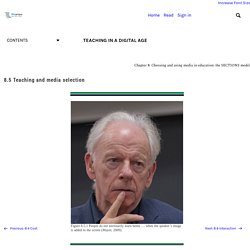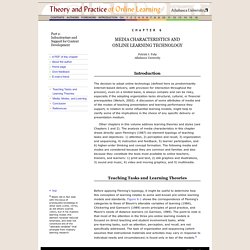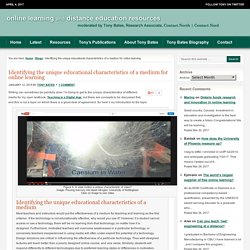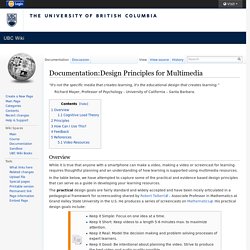

An Error Occurred Setting Your User Cookie. Elearning design: Do we really need narration? When should elearning be narrated?

I think we should rephrase the question as, “When is it a good idea to force all learners to go at the same pace?” That’s what narrated material does. The pace of the narration controls the pace of the material. When you’re learning from narrated material, you can’t easily skim stuff you already know, or slow down and concentrate on the challenging parts, because the voice continues relentlessly at a pace that someone else established. New studies suggest that learner control + text works better According to recommendations in books like Elearning and the Science of Instruction, we shouldn’t narrate text that’s displayed on the screen.
The use of audio in elearning - LEO. What’s the place of audio in elearning?

It can add human warmth. It can provide an authoritative voice. Three Reasons to Love Text in e-Learning. By Ellen Burns-Johnson, Instructional Designer / @EllenBJohnson So there you are.

Your e-learning project is coming along nicely: The content has been validated by SME reviewers, you've adjusted the interface based on feedback from user testing with real learners, and the client team is in the process of reviewing the alpha link. eLearning Instructional Design. ‘Knowing’ vs.

‘Doing’ Our industry is still plagued with elearning designs that focus too much on content (i.e. what the learner needs to know). We believe elearning instructional design should focus on what the learner needs to do. What’s the difference? Michael Allen, our CEO (and best-selling author), defines instructional activity as “interactivity that engages the learner’s mind to do those things that improve ability and readiness to perform effectively.” Learn By Doing with CCAF. Studies Confirm the Power of Visuals in eLearning. We are now in the age of visual information where visual content plays a role in every part of life.
As 65 percent of the population is visual learners, images are clearly key to engaging people in eLearning courses. Moving and still images have been included in learning materials for decades, but only now has faster broadband, cellular networks, and high-resolution screens made it possible for high-quality images to be a part of eLearning visual design. Graphic interfaces made up of photos, illustrations, charts, maps, diagrams, and videos are gradually replacing text-based courses. In this post, we will dig deep into some statistics and facts to further convince of why eLearning developers should embrace visuals when creating their courses. 1.
Both the short-term and long-term memory store information in chunks, but the former is limited. According to Dr. TEACHING TIPS – 10 FACTORS IN MEDIA SELECTION. 8.5 Teaching and media selection. 8.5.1 The importance of design in multimedia teaching Chapter 7 discussed the various pedagogical differences between media.

Identifying appropriate uses of media is both an increasingly important requirement of teachers and instructors in a digital age, and a very complex challenge. This is one reason for working closely with instructional designers and media professionals whenever possible. Teachers working with instructional designers will need to decide which media they intend to use on pedagogical as well as operational grounds, which was the purpose of Chapter 7. However, once the choice of media has been made, by focusing on design issues we can provide further guidelines for making appropriate use of media. Mayer’s research focused heavily on cognitive overload in rich, multimedia teaching. 8.5.2.1 Coherence People learn better when extraneous words, pictures and sounds are excluded rather than included.
Chapter 6. Chapter 6 Media Characteristics and Online Learning Technology Patrick J.

Fahy Athabasca University The decision to adopt online technology (defined here as predominantly Internet-based delivery, with provision for interaction throughout the process), even on a limited basis, is always complex and can be risky, especially if the adopting organization lacks structural, cultural, or financial prerequisites (Welsch, 2002). Identifying the unique educational characteristics of a medium for online learning. Writing can sometimes be painfully slow.

I’m trying to get to the unique characteristics of different media for my open textbook, Teaching in a Digital Age, but there are concepts to be discussed first, and this is not a topic on which there is a great deal of agreement. So here’s my introduction to the topic Figure 9. Is slow motion a unique characteristic of video? Image: Pouring mercury into liquid nitrogen: University of NottinghamClick on image to see video Most teachers and instructors would put the effectiveness of a medium for teaching and learning as the first criterion. Figure 9. FACTORS OF METHODS, MEDIA SELECTION, TIME AND EVALUATION, IN INSTRUCTIONAL SYSTEM DESIGN AND DEVELOPMENT – Yaaka Digital Learning Network. Documentation:Design Principles for Multimedia. “It's not the specific media that creates learning, it's the educational design that creates learning.”

Richard Mayer, Professor of Psychology – University of California – Santa Barbara. Overview While it is true that anyone with a smartphone can make a video, making a video or screencast for learning requires thoughtful planning and an understanding of how learning is supported using multimedia resources. In the table below, we have attempted to capture some of the practical and evidence based design principles that can serve as a guide in developing your learning resources. The practical design goals are fairly standard and widely accepted and have been nicely articulated in a pedagogical framework for screencasting shared by Robert Talbert – Associate Professor in Mathematics at Grand Valley State University in the U.S. The research informed principles are largely based on the work of Dr. Cognitive Load Theory Principles How Can I Use This? Feedback References Clark, R. Video Resources.